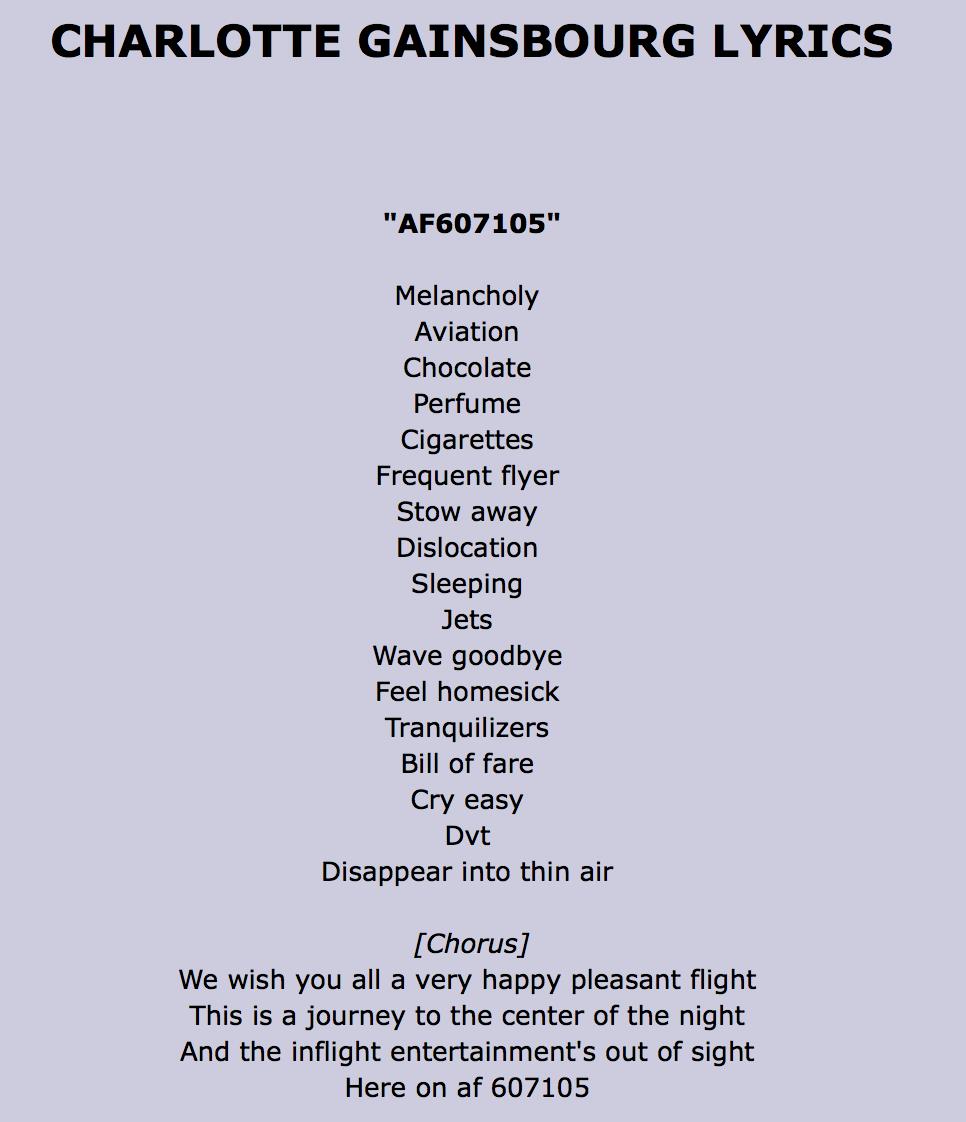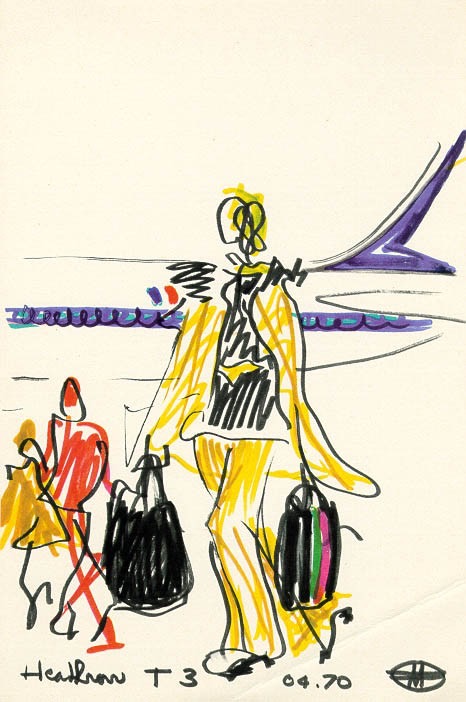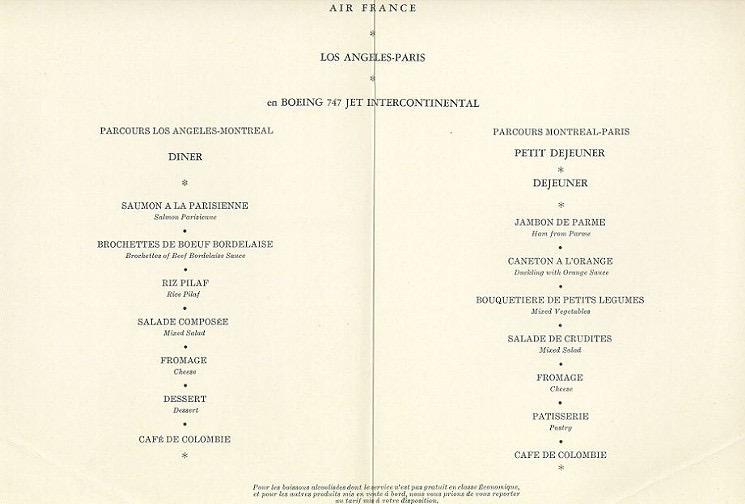Alexandra Myshalov
Flying Air France
ISSUE 71 | THE FRENCH ISSUE | JAN 2017

I gave Charlotte Gainsbourg a shot when I ran out of her father’s music to listen to, having exhausted even his troubling reggae releases. I didn’t care for her particularly, but her song AF607105, which was apparently catchy enough for me to remember the string-of-numbers title without looking it up, made enough of an impression that I’d like to look at it briefly. If it were not so tongue-in-cheek, Air France would probably have used it in an advertisement by now. Her bland delivery captures neatly the affective terrain inhabited by the sort of seasoned traveler people like imagining themselves to be. The savvy weariness of the frequent flyer who carries a TUMI and checks an aluminium Rimova, orders a Bloody Mary onboard, wouldn’t be caught dead with one of those neck pillows. Although flying has lost some of the luxury of its earlier days, it’s still only a portion of the population that flies at all. The data to calculate how many people in the world have flown isn’t available, but estimates put it as low as five percent. Eighteen percent of Americans have never flown, and most of the people that do fly are the ones who do it regularly, usually for business. Large, full service airlines are still in the business of marketing glamor. Or in the case of Air France, marketing chic.

Air France, stylized AIRFRANCE, was established as France’s flag carrier in 1933 in the merger of Air Orient, Air Union, Compagnie Générale Aéropostale, Compagnie Internationale de Navigation Aérienne (CIDNA), and Société Générale de Transport Aérien (SGTA), five early airlines. The interlude between the First and Second World Wars saw the rapid expansion of civil air transport around the world as aviation technology, which had reached maturity during the Great War, was put to peacetime use. Politics being then, as now, war by other means, competition ensued between France, the United Kingdom, Belgium, the Netherlands, and Portugal for civil air supremacy, particularly in those places they had colonized. Italy, Germany, and the United States played roles as well, but those four were the foremost imperial powers at the time and as such had more at stake in the scramble to connect their sprawling colonial empires. This renewed competition among the European colonial powers recalled the earlier “scramble for Africa”; competition for territory and natural resources was replaced by competition for routes, access, and ports of call that would facilitate the movement of mail, cargo, and people. The networks established during this era survived the empires that had created them, living on to shape geography and channel flows of people, goods, and capital in ways that must be teased out, addressed.
“Air is anywhere and forms an everywhere continuous and entirely uninterrupted base of traffic, whereas water and land surfaces interpenetrate . . . Without any doubt, therefore, air is the most perfect way of communication and makes possible the noblest and freest method of transport. This element, however, seems to be reserved for future times of greater inventiveness in which human intercourse will reach its highest perfection. its mightiest development, and its greatest freedom.”
Penned in 1841 by geographer J.G. Kohl, author of the first systematic treatise on the geography of communications, these words come to us from the earliest days of heavier than air flight, with Lillienthal twenty years away and the Wrights sixty. Kohl highlights the seeming immateriality of air, “a base of traffic” with no interruptions, a perfect, smooth, neutral expanse. As the skies grew busier, it was precisely these properties of air that allowed for the reconfiguration of time and space according to the vagaries of capital. Civil and wartime aviation introduced striation, gathering up and warping the Earth’s surface to create new, non-Cartesian geographies. Air links have a unique potential to draw physically distant places closer to one another while making physically proximate places relatively more remote. The former phenomenon, called a “wormhole” by geographers, forms wherever the vagaries of capital dictate that the positionalities of two far apart places overlap. The latter, called a “travel-scarp”, condenses in those places rendered marginal by processes of globalization: flyover country.1 There are no major hubs inside of the triangle formed by Madrid, Johannesburg, and Dubai, nor between Mexico City and Buenos Aires.
Civil aviation has always involved a complicated supranational dance of governmental, non-governmental, and quasi-governmental entities. Unprofitable as a general rule, those airlines that did not begin as outright national enterprises were only nominally private: “Only through governmental subsidy could transoceanic airlines exist. Governments were, however, willing to pay the bill, partly for defense needs but more commonly as a cost of maintaining adequate communications with their colonies.” This willingness weathered decolonization: the French government, and flag carrier Air France were instrumental in setting up Air Afrique in 1961 to serve Francophone Africa and maintain links (and more importantly, French control of those links) with metropolitan France. Air Afrique soon dropped money-losing domestic routes while maintaining longer haul connections, choosing profit over providing accessible service to the populations it was ostensibly serving, veiling much of West Africa behind a travel-scarp.
Air France is best described as painstakingly French. The uniforms, redesigned in 2005, are by Christian Lacroix, who had the following to say regarding the project:
“Designing a uniform for Air France, France’s roving ambassador, that is totally open to cultures the world over, is a wonderful opportunity. To some extent, Air France and high fashion belong to the same world, which has to reconcile traditions and technologies, and whose aim is to project and perpetuate the French style of gracious living…”
Each passenger receives a tasteful menu instead of the typical verbal “chicken or lasagna”, from which they can select a multi-course meal showcasing a certain idea of French cuisine, heavy on the paté and petits fours. Complimentary champagne is served, even in coach. The staff take a certain pleasure in asserting that once you have stepped foot on an Air France operated flight, you are on your way, and aren't you happy to be leaving wherever it is you were? Of course you are, because you are on your way to la métropole… Ah, you have a connecting flight? That’s ok… We’re happy to be just a stop on your way, and such a lovely one at that…


Imperialism gives way to Empire, which “establishes no territorial center of power and does not rely on fixed boundaries or barriers, [a] decentered and deterritorializing apparatus of rule that progressively incorporates the whole global realm within its open, expanding frontiers”; the pathways along which dispossession is administered remain largely untouched. If it ain’t broke, why fix it? Likely, air travel encouraged the transition of Empire to begin with. Bananas and sugarcane are replaced by Hiltons and Four Seasons, plantation owners by technocrats carrying on the old mission civilatrice of colonial policy, rebranded as development. It is worth noting that the word air, which is English by way of French, can of course also be used in the sense of putting on airs, or to say that someone seems a certain way, il a l’air triste, non? And as well that the air has never been as serene as the German geographer would have had it, fraught with rough air and storms that will blot a plane out like a smudge on a mirror. 
1 This happens with ground transportation as well; the narrative of the town bypassed by new freeway construction is a familiar one. The nodal (rather than arterial) organization of air routes, coupled with the fact that one flies over a place rather than through it, making no stops, means flight has the greater potential to relegate swaths of territory to the status of hinterland.